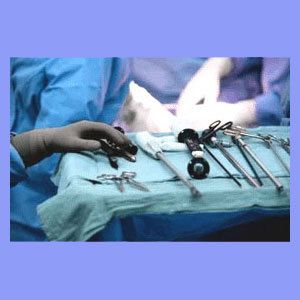
Laminectomy for sciatica is truly traditional spinal surgery in its purest form. Besides spinal fusion, there are few fully open procedures which create so much damage to the healthy spinal tissues and often leave the patient with a permanent functional disability. However, all is not so gloomy. Newer hemilaminectomy procedures are less invasive and can accomplish their surgical goals without causing too much collateral damage to healthy tissues in the spine.
This article will describe laminectomy, as used to treat sciatic nerve symptoms. We will look at why the operation is selected and the conditions it is meant to resolve.
Laminectomy Surgery Explained
Laminectomy can be performed using a single large surgical incision or several smaller incisions. The latter option is commonly called a hemilaminectomy and is a more enlightened minimally invasive form of the procedure.
The surgeon will dissect the levels of back musculature, in a traditional open technique, or simply move them aside in minimally invasive versions, thereby accessing the spine directly. Once the spine is visualized, the surgeon will remove sections of bone called lamina.
The purpose of this procedure is to enlarge the foraminal openings through which the nerve roots leave the spine. The central canal may also be widened in cases of spinal stenosis. Sometimes, bone spur growth is removed in osteoarthritis patients, and other times, the facet joints are trimmed to eliminate suspected causes of pain.
This surgical technique is commonly performed in conjunction with a discectomy, if the symptomatic causation is disc-related in any way.
Laminectomy for Sciatica Concerns
The full open version of this procedure is brutal on the poor patient and takes significant recovery time to regain lost functionality. Some postoperative patients continue to have their original pain, which is a good indication of misdiagnosis, and many also have additional symptoms due to the surgery itself.
Enduring such a torturous procedure and still having pain seems a fate worse than death, but it is an unfortunate reality for many people who’s hopes for a recovery were dashed by the poor curative results offered by this old school sciatica operation. Of course, being that all versions of this surgical technique are quite drastic, there are all the usual risks of sciatica surgery to consider. These include poor results, infections, spinal fluid leaks, nerve damage, scar tissue formation, permanent functional loss and even death.
Intimate Experience with Laminectomy for Sciatica
This procedure is used to treat a variety of spinal pain syndromes most commonly linked to foraminal stenosis or spinal stenosis. The actual suspected source of pain might be a herniated disc, bone spur or other causation, but the treatment is almost cookie-cutter, regardless.
I grew up looking at the 6 inch scar on my mother’s lower back, caused by her laminectomy in the 1960’s. She had her operation before I was born and spoke of it often. Her doctor performed this surgery to correct a herniated disc in her lower back, ironically one of the same that I have now (L4/L5 and L5/S1 for me).
Mom never got fully better and spoke of her back pain almost daily. She could not do so many things in life, but luckily found solace in swimming; her great love. The scar was frightening, but the fact that the procedure did not cure her pain was even scarier. She continued to suffer with back pain which came and went throughout her life and remained in medical and chiropractic treatment for many years. Now mom is gone, but my memories of her brave struggle with back pain, hip replacements and finally cancer, are alive and vivid.
Laminectomy is rarely necessary, except in extremely dire cases of osteoarthritic growth. In my experience, it often does more harm than good. My advice would be to consider another option if this procedure is suggested to you. There are many other sciatica treatment modalities which might offer better results and might not even entail surgical intervention.
However, in particular scenarios, laminectomy does provide the best possible treatment strategy for significant bone-related foraminal and central canal impingement issues. In these instances, minimally invasive versions of the procedure should be used whenever possible for optimal results.





